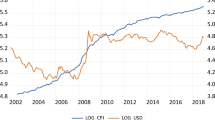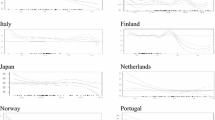Abstract
We incorporate technical trading into the monetary approach to exchange rates, and estimate the model for four Central and Eastern European countries that introduced the policy of free floating in the late 1990s; the Czech Republic, Hungary, Poland and Slovakia. We find that past exchange rates contribute significantly to the determination of the spot exchange rate. We also find a feedback behavior driving the exchange rate to its fundamental value although the mean reversion parameter is small. Overall, this means that these currency markets have developed a complex structure of different trader types, which already is documented for developed countries.
Similar content being viewed by others
Notes
A detailed description of the empirical analysis is available on request from the authors that also includes results discussed in the paper but not found in the tables.
No adjustment is made after the accession of Slovenia to the euro area in January 2007. However, since the size of Slovenia’s economy in relation to the other economies in the euro area is very small, this error should be negligible.
The unit root test in levels includes an intercept and a trend, while the test in first differences includes only an intercept.
We extend the estimation specifications by dummies for special events including the EU membership of the new member states (from May 2004 to the end of sample) and the period of changeover from national currencies to the euro (January 1999 to December 2001). The specification for the Czech Republic also includes dummies for the currency crisis in May and June 1997, and the specifications for Hungary and Poland also include dummies for the periods of inflation rate targeting (from June 2001 and January 2002, respectively, to the end of sample). Finally, the specification for Slovakia also includes dummies for the pre-reform period between January 1993 and October 1998, and the change of the ERM II parity in March 2007. However, we have to keep in mind that the critical values of the cointegration test are not valid if dummy variables are included.
As an alternative to the asymptotic critical values, we also used finite-sample critical values according to Cheung and Lai (1993). The results have remained unchanged. Further problems could be caused by heteroscedasticity of exchange rates. Nevertheless, Wong et al. (2005) argue that conditional heteroscedasticity is likely to be weak if cointegration exists, which is confirmed by our tests.
There is an alternative interpretation of θ: Instead of assuming that agents using fundamental analysis have rational expectations, assume that the time horizon in currency trading is determined by rational expectations and that agents using fundamental analysis believe that the exchange rate will return to its fundamental value. As before, agents using technical analysis use a moving average technique in currency trading. In such a model, θ would be a measure of the adjustment speed of the exchange rate to its fundamental value. See Bask (2007) for a time-continuous model with these characteristics.
The relevant dummies include the period of inflation targeting in Hungary and Poland, and the change of the ERM II parity in Slovakia in March 2007 (see footnote 4).
References
Andrews DWK, Zivot E (1992) Further evidence on the great crash, the oil-price shock, and the unit-root hypothesis. J Bus Econ Stat 10:251–270
Artis MJ, Marcellino M, Proietti T (2003) Dating the Euro area business cycle. Discussion Paper No. 3696. CEPR, London
Bask M (2007) Chartism and exchange rate volatility. Int J Financ Econ 12:301–316
Bask M (2008a) Adaptive learning in an expectational difference equation with several lags: selecting among learnable REE. Eur Financ Manag 14:99–117
Bask M (2008b) Announcement effects on exchange rates. Int J Financ Econ (in press)
Bauer C, Herz B (2007) Credibility of CIS exchange rate policies – a technical trader’s view. Emerging Markets Review 8:50–66
Brock WA, Hommes CH (1997) A rational route to randomness. Econometrica 65:1059–1095
Cheung Y-W, Chinn MD (2001) Currency traders and exchange rate dynamics: a survey of the US market. J Int Money Financ 20:439–471
Cheung Y-W, Chinn MD, Pascual AG (2005) Empirical exchange rate models of the nineties: are any fit to survive? J Int Money Financ 24:1150–1175
Cheung Y-W, Lai KS (1993) Finite-sample sizes of Johansen’s likelihood ratio tests for cointegration. Oxf Bull Econ Stat 55:313–328
Chmelarova V, Schnabl G (2006) Exchange rate stabilization in developed and underdeveloped capital markets. Working Paper No. 636. European Central Bank, Frankfurt
Crespo-Cuaresma J, Fidrmuc J, MacDonald R (2005) The monetary approach to exchange rates in the CEECs. Econ Transit 13:395–416
Crespo-Cuaresma J, Fidrmuc J, Silgoner MA (2008) Fundamentals, the exchange rate and prospects for the current and future EU enlargements: evidence from Bulgaria, Croatia, Romania and Turkey. Empirica 35:195–211
Crespo-Cuaresma J, Hlouskova J (2005) Beating the random walk in central and eastern Europe. J Forecast 24:189–201
De Grauwe P, Grimaldi M (2006) The exchange rate in a behavioral finance framework. Princeton University Press, Princeton
De Long JB, Shleifer A, Summers LH, Waldmann RJ (1990) Noise trader risk in financial markets. J Polit Econ 98:703–738
Égert B, Halpern L (2006) Equilibrium exchange rates in central and eastern Europe: a meta-regression analysis. J Bank Financ 30:1359–1374
Égert B, Jiménez-Rodríguez R, Kočenda E, Morales-Zumaquero A (2006) Structural changes in central and eastern European economies: breaking news or breaking the ice? Econ Change Restruct 39:85–103
Elliott G, Rothenberg TJ, Stock JH (1996) Efficient tests for an autoregressive unit root. Econometrica 64:813–836
Evans GW, Honkapohja S (2001) Learning and expectations in macroeconomics. Princeton University Press, Princeton
Fidrmuc J (2008) Money demand and disinflation in selected CEECs during the accession to the EU. Appl Econ (in press)
Fidrmuc J, Horváth R (2008) Volatility of exchange rates in selected new EU members: evidence from daily data. Econ Syst 32:103–118
Frankel JA, Froot KA (1986) Understanding the US dollar in the eighties: the expectations of chartists and fundamentalists. Econ Rec S62:24–38
Friedman M (1953) The case of flexible exchange rates. In: Friedman M (ed) Essays in positive economics. University of Chicago Press, Chicago, pp 3–43
Gehrig T, Menkhoff L (2006) Extended evidence on the use of technical analysis in foreign exchange. Int J Financ Econ 11:327–338
Hamilton JD (1994) Time series analysis. Princeton University Press, Princeton
Hanousek J, Filer RK (2000) The relationship between economic factors and equity markets in central Europe. Econ Transit 8:623–638
Hommes CH (2006) Heterogeneous agent models in economics and finance. In: Tesfatsion L, Judd KL (eds) Handbook of computational economics, vol 2. Agent-based computational economics. Elsevier/North-Holland, Amsterdam, pp 1109–1186
Ito T, Yabu T (2007) What prompts Japan to intervene in the forex market? A new approach to a reaction function. J Int Money Financ 26:193–212
Kirman A (1993) Ants, rationality, and recruitment. Q J Econ 108:137–156
Lui Y-H, Mole D (1998) The use of fundamental and technical analyses by foreign exchange dealers: Hong Kong evidence. J Int Money Financ 17:535–545
Kočenda E, Valachy J (2006) Exchange rate volatility and regime change: visegrad comparison. J Comp Econ 34:727–753
MacDonald R, Wójcik C (2004) Catching up: the role of demand, supply and regulated price effects on the real exchange rates of four accession countries. Econ Transit 12:153–179
McCallum BT (1983) On non-uniqueness in rational expectations models: an attempt at perspective. J Monet Econ 11:139–168
Meese RA, Rogoff KS (1983) Empirical exchange rate models of the seventies: do they fit out of sample? J Int Econ 14:3–24
Menkhoff L (1997) Examining the use of technical currency analysis. Int J Financ Econ 2:307–318
Neely CJ (1997) Technical analysis in the foreign exchange market: a layman’s guide. Federal Reserve Bank of St. Louis Review 79(5):23–38
Oberlechner T (2001) Importance of technical and fundamental analysis in the European foreign exchange market. Int J Financ Econ 6:81–93
Oberlechner T (2004) The psychology of the foreign exchange market. Wiley, West Sussex
Pramor M, Tamirisa NT (2006) Common volatility trends in the central and eastern European currencies and the euro. Working Paper No. 6/2006. IMF, Washington
Taylor MP, Allen H (1992) The use of technical analysis in the foreign exchange market. J Int Money Financ 11:304–314
Wong H, Li WK, Ling S (2005) Joint modeling of cointegration and conditional heteroscedasticity with applications. Ann Inst Stat Math 57:83–103
Zeeman EC (1974) On the unstable behaviour of stock exchanges. J Math Econ 1:39–49
Author information
Authors and Affiliations
Corresponding author
Additional information
We are grateful to Elina Rainio for helpful assistance with data and to two anonymous referees for helpful comments and suggestions. The usual disclaimer applies.
Appendix: Proofs
Appendix: Proofs
Proof of Lemma 1
First, expectations formed by fundamental analysis and chartism in Eqs. 3–4 are substituted into market expectations in Eq. 1:
Second, substitute the weight function in Eq. 2 and the long-period moving average in Eq. 5 into Eq. A.1:
Finally, substitute Eq. A.2 into the baseline model in Eq. 11, solve for the current exchange rate, and the proof is completed.□
Proof of Proposition 2
Given the solution in Eq. 15, determine the next time period’s exchange rate, substitute this exchange rate into the expectational difference equation in Eq. 13, and solve the resulting equation for the current exchange rate:
where
has been utilized in the derivation. That is, it is assumed that the fundamentals are constant over time. Then, the equation system for the parameters \(\left\{ \beta _{j}\right\} _{j=0}^{j_{\max }}\) in Eq. 16 is derived by comparing the parameters in Eq. 15 with those in Eq. A.3, and the proof is completed.□
Rights and permissions
About this article
Cite this article
Bask, M., Fidrmuc, J. Fundamentals and Technical Trading: Behavior of Exchange Rates in the CEECs. Open Econ Rev 20, 589–605 (2009). https://doi.org/10.1007/s11079-008-9095-3
Published:
Issue Date:
DOI: https://doi.org/10.1007/s11079-008-9095-3




